


NEWSLETTER No 34
HITCHES OVERCOME
JANUARY 2001
Even though committee members invariably get an enthusiastic response to the events they plan, they do tend to chew their nails a bit wondering if a specific event is going to come off well. Especially since there are inevitably last-minute hitches. So it was for our first events of the 2000-2001 season.
The season's lead-off October event saw new Dunning resident (and now DPHS committee member) Alf Marshall deliver a superb slide talk on his area of professional expertise: the history of carpet designing. Vital of course to the presentation were Alf's colourful slides. The unexpected hitch: we realised at the last minute that because of the tattie holidays, the slide-screen we usually use was locked away in the school and unavailable. Alf enterprisingly found and borrowed a screen we had never known existed, from the church. Hitch overcome, fine evening!
Our second event, the November themed coffee morning was a bit of a trembler until the last minute. The theme was "My Favourite Place in Dunning" with a show of drawings and writing from all the pupils of Dunning Primary. Hitch: the construction of new school offices in the former schoolhouse was behind schedule and creating chaos: we didn't know until the last minute whether the children had even done the assignment as arranged by David Halliday with Jill Tanner. Happily, it was done, just in time, and we report on the terrific results inside.
RAIN
Soft, soft the raindrops dropping soft
as down they fall falling all over
Strathearn pat patterning their gift
at birthing pane and down death's door
at homes where dripping nappies hang
or ancient tree-paired couples dance
a wireless waltz or bored teenagers bang
and stamp frustrated rooms and sense
the wet hot message keen as a sword-
bite swelling the stream-run and runnel
down fissures in yew bark blue beetles ford
with tentative step wetting the wagtail
on a squelchy lawn and the late-night
Dunning drunk head down and westering home
home to oblivion soaking the light
on street-shine and moon-lamp monochrome
lovers lost in lee of the kirk yard wall
and under the beech hedge the old tin can
sheltering where Serf first set his cell
dousing kindness and desolation
spring sprinkling the sleeps of old Grannie McLeod
spinning her decades-deep dream shroud
trick trickling in through grave-slab crack
to mist the sight of Dunning Glen black
ferryless waters of the Dunning Burn
tree roots, me, moring - all waiting our turn.
---from a forthcoming book by Walter Perrie, Croft Place, Dunning.
MILLENNIUM CARDS, NOTELETS
Dunning's Millennium Committee is now selling holiday cards (at five for £3, singles 65p) with a striking Tron Square Hogmanay scene by Henry Hoey. The cards are available from committee chair Judi Slater, Kirkgate House, Tron Square, Dunning PH2 0RG, telephone 01764 684 372.
Available in Dunning shops (and from Mrs. Slater and her committee members) are attractive sets of notelets, with sketches by Mary Thomson, Albie Sinclair and Kenny Laing. Cost is £1.75 for a set of nine.
MY FAVOURITE PLACE IN DUNNING
For our themed coffee morning last November we wanted to involve Dunning's schoolchildren, and the committee had the happy idea of inviting all the pupils of the primary school to draw and write about "their favourite place in Dunning".
The resulting exhibit of drawings and writing was absorbing. We include here just a random selection (another small sample,in colour,can be seen on our website www.dunning.mcmail. com).
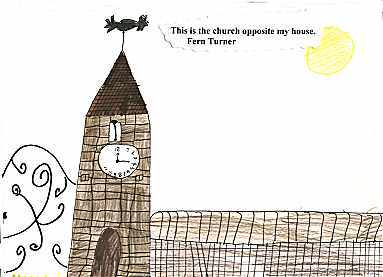
Picture by:- Fern Turner, Primary 2
The autumn leaves are falling in rainbow colours all around you.
In the trees the birds are singing their gleeful songs.
Squirrels are scuttling collecting food for the winter.
The chilled breeze sweeps down your back and makes you shiver.
The dew on the grass looks like crystals on stands.
Sunlight comes down on the sparkling forest.
Where has the path gone?
It's covered in leaves so you can't see it.
---Rachel Sneddon, Primary 6
|
Walking down to the spiritual monument. ---Cameron Matthews, P6 |
The first time I saw the park ---Shelley Dewar, P6 |
|
My favourite place is the building site. ---Nathan Downs, P6 |
My favourite place in Dunning is the burn. ---Lynsey McKay, P6 |
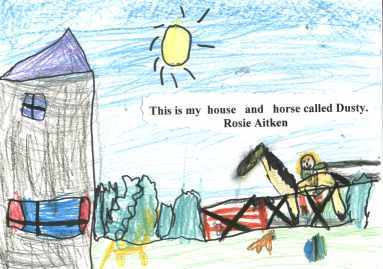
My favourite place in Dunning is my house.
When I get in my house, I see my cat.
When I'm in my bedroom, I hear my mum and I smell my tea.
I smell my chips as it drifts up the stairs.
I feel the air from the window on my hands.
I taste all the happiness that I find here.
---Jonathon Bussey, P5
---Rosie Aitken, P2
With my wellies on and sledge
Up the hill again and go sliding back down
Lots of childrens' footsteps here
Snow coming down and landing on our heads
Then we go for a little play like building snowmen and then smashing them
Way for a little lunch then back to play
Seeing little birds' footprints round the trees and people coming to play
---Stacey Robertson, P6
My favourite place is my bedroom because it is quiet, warm and fun.
I feel happy, comfortable and safe.
---Jenny Kelman, P4
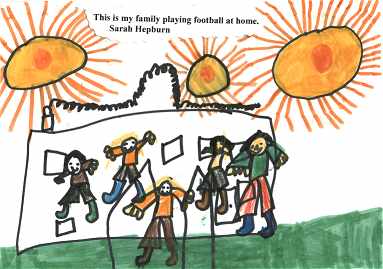
---Sarah Hepburn, P2
My favourite place in Dunning is in my house playing my playstation.
I see the colour on the screen.
It is bright.
I hear sounds like a kick from a fighter,
I smell my mum cooking the tea
it reminds me of the smell at my karate class.
I feel my remote control vibrating in my hand.
I eat my tea at the table
it reminds me of the bad king guy eating his meal.
Dunning
Kirkwynd
my living room
on my playstation
the game Typhoo
Great place to be.
---Gavin McArthur, P5
We'll bring you more of "My favourite place in Dunning" in coming issues. Our thanks to all the children who contributed to the exhibit and to head teacher Jill Tanner and her staff for their help.
LEADKETTY: MORE THAN JUST A PLACE TO BARNDANCE
The feature speaker at our May 11/2000 agm was past DPHS chair Ian Philip. Ian talked about the Dunning corner where he has lived all his life, the cluster of smallholdings called Leadketty. Here's the first part (of two) of a transcription of his talk.
Leadketty as you'll know is a farm just a bit north of Dunning village...you'll have seen the big sign for it along Station Road pointing in to the road end. Nobody has really satisfactorily explained to me the derivation of the name Leadketty. When Angus Watson was here talking about the placenames of the Ochils, he was asked and he didn't come up with much of an explanation but he thought it may have to do with the sloping ground it is on.
The map of the Abbeylands in Strathearn shows lands owned by Inchaffrey Abbey at Madderty and other lands mentioned in pre-Reformation documents, and it has names in Dunning Parish. Two lands possessed by the Abbey were ROSSI and KINCLADI. Other lands on the map were DALREWACH (which is Dalreoch), POLGOUR (Balgour), ENNYR DONYN (Inner Dunning), DUNCROUB (Duncrub), GARVOK (Garvock), PETI KARNE (Pitcairns), PETMADY (Pitmeadow) and LADCATHY (Leadketty). They're all pretty accurately placed on that map.
A later map of 1783 shows the spelling which we now use, Leadketty. Leadketty was owned by the Rollos of Duncrub and the B-listed farmhouse predates the 19th century steading and was originally a Rollo Dower House.
Much of the Duncrub estate was sold in 1923, and although listed in the sale catalogue, Leadketty was still a tenanted farm until 1925 when the then tenant James Bett bought Leadketty. He farmed it until 1930 when it was purchased by the Corrigall family, who had come down from Orkney and farmed until that time at Dollerie near Crieff.
In the 1930s the Department of Agriculture in Scotland was involved in a land settlement scheme. Farms were purchased all over Scotland and then subdivided into smaller units. Houses and steadings were built on them and then these smallholdings were rented out. Most had 6 to 7 acres of land, but there were also a few larger units of approximately 50 acres. Identical houses were built and although the internal layout varied the basic house can be recognised all over the arable areas of Scotland. Of course, many have now been added to and altered.
In Tayside holdings were created at Crieff, Kinfauns, Longforgan, Tealing, Burrelton and Coupar Angus. If you go by Coupar Angus and Burrelton holdings you'll see some amazing additions to these houses.
The smaller units had a house as well as a brick shed 35 feet by 17 feet. Both were harled. The larger units had a house and a small dairy and washhouse, a Dutch barn for straw storage, with a grain store from which it was almost impossible to keep out mice, and a covered cattle court. There was also a brick shed 40 feet by 25 feet subdivided with internal walls to make a byre with stalls for 12 cows, a 2 stall stable for the horses, a loose box for a young horse and a small feed store.
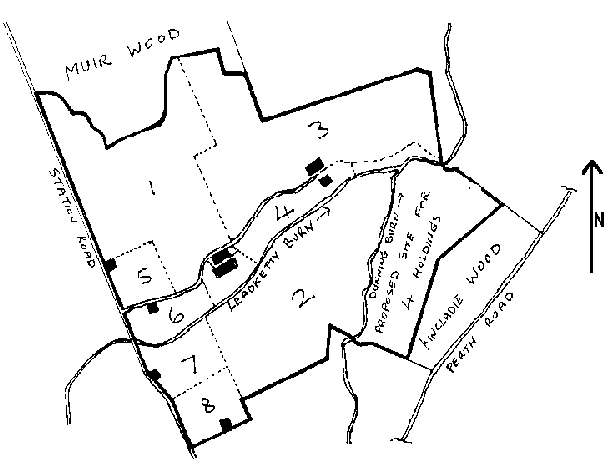
--Map of Leadketty Holdings by Ian Philip
Leadketty was one of the farms purchased by the Department of Agriculture and it was divided into 8 holdings, five of 6 to 7 acres and three of approximately 50 acres. It was intended at the time that another four holdings were to be built on the ground between My Lady's Wood and the Dunning Burn, but the onset of World War II meant that this part of the scheme was abandoned.
The original farm was supplied by water from Duncrub estate and that supply would not have been sufficient for the smallholdings. A new water supply was provided by taking water from the overflow from the filter bed of the Dunning supply in the Den. It was piped from there to the Dunnock where a header tank was installed. From there it was piped down the Granco under the Dunning Burn and down what was then the Ditches to the holdings. Near Station Road the pipe crossed over the Duncrub (or Leadketty) Burn just downstream from the point where the Latch Burn joins the Duncrub Burn. The pipe was set high up the bank near the bridge on Station Road. The pipe was enclosed in a large wooden box insulated against frost. It was not unknown for us children walking home from school to climb over the dyke and cross the burn by this box rather than use the bridge.
This installation caused some controversy over a number of years and it was raised at some of the local elections that Leadketty would use up all the village water supply in a dry year. This despite the fact that it was the overflow being used. That was resolved when the mains water was brought to Dunning down Station Road and the holdings were connected directly to the water main. Meters were fitted to each holding at that time, and much of the pipe work was cut off and made redundant. At the highest point of our farm we had a field trough and with the old supply from the Dunnock it used to fill very slowly because the level of the trough was just below the height of the Dunnock storage tank. After we were connected to the main supply we soon found water appearing in the garden and in digging down to the water pipe (we were at the end of the line) we found that the end of the pipe had a cap on it and the increased water pressure had blown the cap off. The header tank for the mains supply was way up the Gask Brae. We had to put the cap back on and hammer in a metal bar to keep it in place.
Electricity finally arrived in 1952 at the holdings. That was after an impasse when the then owner refused permission for a line to go through his land. It was only settled when Dr. Janet McLaren came to Dunning and moved in to St. Andrew's Cottage. She insisted that as she would be on call at night she required the convenience of having electricity, and it was then made clear that if permission was not forthcoming statutory powers would be used. That was one benefit we got when Dr. McLaren came to the village.
By the early 1980's it was costing the Scottish Office much more to administer and factor the holdings over the country than was being collected in rent, and a decision was made to offer to sell the properties to the tenants. Eventually all the Leadketty holdings reverted to private ownership.
The original farmhouse and steading of Leadketty were divided in two and became two of the large holdings Nos.1 and 2. At No. 3, where I am, the house was built half a mile in from Station Road adjacent to the house of the old farina mill which was used for No. 4 holding.
Then you went back to the Station Road and you started numbering from the top of the brae furthest from Dunning, no 5, 6, 7 down to the one closest to Dunning No. 8.
The holdings started to be occupied in late 1938, and for some of the last ones it was into the forties before they were all occupied.
Occupiers of Leadketty since 1938-9
No. 1: The first tenants were Mr. and Mrs. J.. Reid. Then there were a couple called McLeans (not the ones that we still know). They came from Thornton. Some of you may remember Mrs. McLean: she was quite like Maw in "The Broons" and her husband John was quite a small man. They were always affectionately know as "Maw and the wee man".They didn't stay too long. After they left Peter McLean (DPHS committee member George's father) became tenant and when the holding was up for sale Peter purchased it. When he retired the steading and house were bought by Harold Corrigall of No.2 holding, and I acquired the land.
No. 2: The tenant was the Corrigall family who had originally owned the whole farm. They managed to get the tenancy of it, and the original farmhouse, and it's still son Harold Corrigall who is in that holding as the owner. Incidentally their holding was slightly bigger than the fifty acres because that extra land I spoke about which was going to have another four holdings on it was adjacent to the Corrigall fields and was added to their land.
No. 3: It was my father Alex Philip who came there in 1939, and I'm still there. It was purchased too, and I also have the land which was on No. 1 holding, plus small pieces of ground from Nos. 4 and 5 holdings.
No. 4: Mr. and Mrs. Cairns were the tenants there at what was the old farina mill. Eventually the field was amalgamated with my holding. Latterly Mrs. Cairns' grandson, Arthur Wright who worked with me, has purchased the house and renamed it Farina Mill. Arthur wrote about his property in our DPHS Newsletter 24.
No. 5: This holding is the one at the top of the hill on Station Road. That was first tenanted by Bob and Mrs. Duncan. When they retired Harry and his wife Mrs. Nellie Duncan (who now stays up opposite the garage), were in there for quite a long time. The house was purchased latterly by James Reid and his wife: James had been brought up in holding No. 1.
No. 6: The first tenants were Will and Mrs. Malcolm, and then when they retired and moved out, the tenancy went to Dougie McIntyre, whom some of you will know and who still lives in the village. When the holdings were sold No. 6 was purchased between Dougie McIntyre and the Fentons at Duncrub. You may notice that it's now named Dalrin. It was the Fentons who named it Dalrin, and it's not a name that means anything but is derived from the Christian names of the Fenton family: David, Audrey, Linda, Ray, Isla, Neil. When they sold it it was bought by a couple, the Simpsons, who were teachers at Dollar Academy but they emigrated to Australia. Then it was bought by another teaching couple, the McEwans, who taught at the convent, then went to Italy and afterwards to St. Andrew's. Presently the property is for sale and quite a lot of folk have been looking over it..
No. 7. The first tenant was John Stewart, who stayed there with his mother. It was purchased by David Corrigall, then by a chap who had a holding at Burrelton, Alan Gray, and then it was sold to the English couple, the Clearys. They were the folk who dug out the fish pond. Now the chap who owns it is John Lamb.
No. 8. The first tenant of the last holding was George Rutherford. when he retired Peter McLean obtained the tenancy. When the McLeans moved up to No. 1 holding, Peter's brother Neil McLean and his family obtained the tenancy of No. 8. They purchased it and it was sold on to Graham and Isobel Ross. They called it Springpark, simply because they liked the name.
That's a breakdown of the people involved with the holdings..
The first thing that happened to most of the holdings was that as the buildings were very basic, and there really wasn't a lot of extra space about, so most of the buildings had bits and pieces added here and there. I remember my father telling me that the first year that he came there was no place really to store turnips inside. He had the cattle in the reed. There was a very hard frost and they had a job cutting the turnips. They finished up tipping cartloads of turnips in the burn to get them thawed out a bit, enough to get them split. So that was one of the first things that took place at No. 3, building a turnip shed. It was difficult getting material at that time because it was just at the start of the war. But my father managed to buy a big wooden shed somewhere and it was brought down and a lot of wooden sheds and hen houses were made out of it, some standing yet.
(Part two of this transcribed talk by Ian Philip will be carried in our next newsletter. In it, Ian describes the types of farming which evolved at Leadketty. These mirrored, he says, the great changes in agriculture taking place across Scotland.)
MY FAVOURITE PLACE IN DUNNING
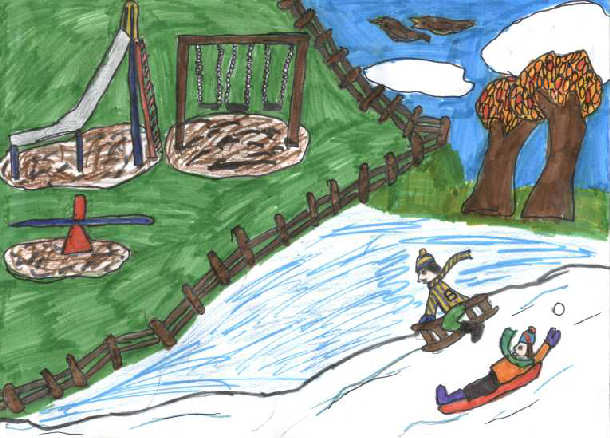
--Olivia Philips, Primary 6
CAN WE HELP YOU?
A stated aim of the Society is to assist and encourage anyone who wishes to undertake any project of local historical interest. This might be research into some event in the very distant past, researching a family tree, or reporting an event taking place today which will soon be history. Or if you have taken an interesting photograph which could be used on our website or feel you could write an informative article for the magazine or keep an audience entertained for a few minutes on members' night, we'd love to hear from you.
Examples of such projects are Ian Philip's recent talk on Leadketty transcribed in this issue, and the many letters of reminiscence from distant members which appear in the newsletter.
If you need help with your project we can often put you in touch with like-minded people, or provide access to our own archives and the internet. (We recently found the present day name and address of a mining company for a member who only knew the initials it went by fifty years ago). So long as the project is appropriate to the Society and we believe it will not incur a financial loss, we can even assist with the finance, as the recent publications of the calendar, the Keelies book and the videos have shown.
We probably have more "active" members than most clubs, societies and associations, but we would very much like to see more. Maybe you don't wish to get involved with "committee work", but you have an idea in your head, or a question you'd like to find the answer to. The committee is very keen to help members like you follow these things through.
--Simon Warren, DPHS Webmaster, Dunning
AN ACCOUNT OF MAGGIE WALL: ACCURATE? NO! IMAGINATIVE? YES!
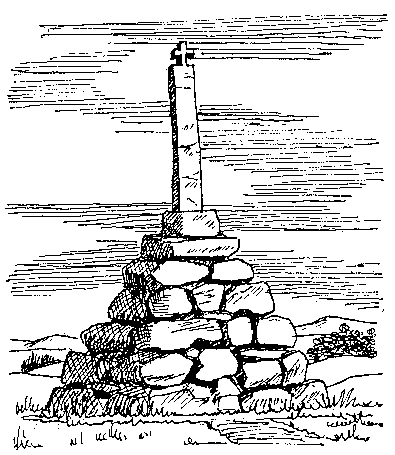
The following is from the Strathearn Herald of 1924. The author is un-named. The clipping was seen by Kirsty and David Doig in a scrapbook of former St. Serf's minister, Dr. Peter Thomson.
(sketch by Kenny Laing)
Maggie Wall. - Story of a Perthshire Village.
In a wood by the side of the road from Aberuthven to Dunning, Perthshire, there is a heap of grey stones with a cross on top, and the inscription "Maggie Wall, burnt here as a witch, 1657".
Dunning is a quaint old village with an ancient thorn tree planted to commemorate some obscure rising, and the medieval custom of ringing the curfew every evening at eight o'clock. The church, too, is worthy of close study and could afford interest to anyone who might care to trace the history of the village. The inhabitants, though, are inarticulate--they cannot express themselves--for when I asked the man who rings the curfew the meaning of certain cryptic signs in the church wall--"Ah," he said, "I couldn't just tell you". Neither could I derive further information concerning "Maggie Wall".
But, going back to Aberuthven that evening, I pieced together what few facts I had gathered or surmised, and filled in the details according to the picture my imagination had made.
It was only twelve years since Prince Charlie had made his desperate effort to win his throne and his glory, and nearly everyone in Dunning had lost someone in his cause. And after her death the old men of the village recalled the queerness of Maggie Wall just before that dreadful time. She had been seen in the churchyard in the moonlight at nights, when the frost lay thick and white on the hard ground, and the very bats were still and the owls silent, uncannily silent. People swore to lights in the kirk, and to strange marks of disturbance round the foot of tombstones.
At the time they had treated old Maggie with awe--respect, too--for she had a simple knowledge of herbs and their medicinal purposes. She could cure fevers and ease women and quieten children---if she was in the humour.
But then, in the March of 1657, following a hard winter when potatoes and oats were terribly scarce, there had been an epidemic that had affected all the children, and carried off many of the older people too. At the beginning of the outbreak a woman went up to Maggie's lonely hut, and inquired as boldly as she dared if Maggie would come down and heal her children and other sick children in the village. But all her entreaties were useless, and after standing outside the hut in the driving wind and rain for more than an hour, she had to return and inform her neighbours that she was unsuccessful for, after receiving the answer "No" to her first question, there had been no other sound from Maggie's hut.
They did not realise that it had been a hard winter for Maggie too, for she was half starved and half frozen, and far too accustomed to independence to think of asking for assistance from anybody.
Other women tried to move her to compassion and met with the same lack of success. Then, with the warmer weather, their affliction ceased, and for a while Maggie was left in her seclusion. Then, one evening in May, a pile of wood and rubbish was gathered for a huge bonfire, and one of the lads suggested in fun "Let's burn Maggie, the witch". And immediately the idea spread, and resentment against Maggie that was half-smothered all this time flared up and took hold of everyone.
By common consent, the faggots etc. were tranferred from the village square to a clearing in the wood just outside the village. The pile was built higher and higher, and all manner of things were sacrificed "to make the witch burn".
Just at dusk, as if by coincidence, Maggie was seen entering the village for the first time for some months. She was frailer and older and more bent, but none noticed that in the general excitement. The prevailing idea amongst the villagers was vengeance for what they considered the murder of their children. As if Maggie Wall was responsible for the failure of the crops, and for the wellbeing of every soul in the vicinity!
She was seized, hoisted shoulder high, and marched round the village square down to the stake, accompanied by men bearing lighted torches, ready to fire the first faggot. Yet, amid all the shouting and crying, it was noticed that she uttered no sound and made no protest. Perhaps if she really had knowledge of the supernatural, she had foreseen that this would happen, and had prepared herself to face it.
Even when the fire was lit and the flames crept slowly up, while gradually the smoke stupefied the poor woman so that the terrible scorching agony of the flames was lessened slightly, no sound passed her lips, though the writhings and contortions of features and limbs, even after death, were horrible to see. So horrible that a hush fell on everyone who witnessed that scene, and a feeling of regret, almost of disgust, that they had burned a woman---a witch, perhaps, but still a woman.
---Author unknown, Strathearn Herald, 1924
To the Editor, Strathearn Herald, 1924.
The article on the subject of Maggie Wall in last Monday's issue, interesting as it is in many ways, is distinguished for its obvious inaccuracies.
It is quite correct to describe Dunning as a "quaint old village " and to put on record the happily surviving "medieval custom of ringing the curfew every evening at eight o'clock". What is said about the venerable parish church is also very well put.
The criticism of the "man who rings the curfew" for his uncommunicativeness might have been left out---the ringer's modesty, very probably, making him hesitate to commit himself.
The first inaccuracy of the writer of this article is this: what he is pleased to call an "obscure rising", leading to the planting of the famous thorn tree, was (as he might easily have learned before leaving Dunning for Aberuthven) the by no means obscure Rebellion of 1715, when the village was burnt after Sheriffmuir.
The biggest inaccuracy of all is perpetrated when the writer, back to Aberuthven, begins his "surmises". His "imagination", your readers will observe, takes a pretty big liberty indeed in ante-dating Prince Charlie by a century! He seems to think the "Forty-five" was 1645 (12 years before Maggie Wall's time), instead of 1745!
-- Peter Thompson
--The foregoing article and reply were taken from the scrapbook of clippings collected by the Minister of St. Serf's, Dr. Peter Thompson, and preserved by DPHS members Kirsty and David Doig.
MAGGIE MAINTAINED
Maggie Wall's monument was spruced up this year thanks to the initiative and funding of Dunning Community Council. Early in the year David Doig repaired the fence with material supplied by neighbouring farmer David Neil. Then, this autumn, mason Stewart Henderson cemented the interior core, preserving the loose stone cairn appearance.
FAREWELL TO GEORGE
On October 28, 2000, George Boardman died. He and his wife Helen had been two of the sparks behind the 1994 and 1999 reunions of Dunning evacuees, and it was primarily George with another ex-evacuee Lily King who organised the evacuees' church service in 1995. It culminated in the unveiling of the plaque on the kirkyard wall in Tron Square, thanking the village for taking in World War II evacuee.
George and Helen had no children of their own but for many years had played an important part in raising several nieces and nephews. George had told them often his stories of being evacuated to Dunning in September 1939 with his mother, and of his stay here. When George's remains were cremated, it was a nephew who suggested to Helen that Dunning would be a fitting place for the ashes to be scattered.
So on November 5 the family group journeying from Glasgow was joined by several Society members for an impromptu farewell in St. Serf's kirkyard. Chair Liz Fletcher and past chair Ian Philip spoke, and then the Society invited the family to the old schoolhouse for refreshments.
Here is a note to "Dear Liz and friends" from Plymouth, Devon:
"On behalf of my sisters June, Carol, Janice and my brother Billy, our husbands and our children, I would like to thank you for your kindness, warmth and hospitality extended to us when we arrived in your lovely village to scatter our beloved Uncle George's ashes in your graveyard.
Uncle George loved Dunning all of his life and always talked fondly of his time there. That love continued not only for days gone by but also because of many recent memories and special friendships that were made along the way.
The shock and formality of a funeral was made easier to bear knowing Uncle George'e ashes would be scattered at the place he loved more than anywhere else in the world.
Uncle George has been a major part of our lives since we were born and we loved him so much. He gave us his time and love without conditions or limits. You greeted us so warmly that we all felt this really was home for Uncle George. The sincerity and love that we felt from you reassured us that we were leaving his ashes in the right place. This gives us great comfort. Now I know why Uncle George loved Dunning so much. It's not just the natural beauty of your village or the location, it is the people of the village that are its heart and soul. Thank you all.
--Lorna Smith, Plymouth
LETTERS
The Dunning Historical Society and his ex-Evacuee friends will be saddened to hear of the death of George Boardman.
His willing and tireless work during the initial contacting and advising of the first Evacuee Reunion (and subsequent) events, was undertaken with a thoughtfulness and enthusiasm typical of this gentleman.
He was the instigator and was mainly responsible for the raising of funds for the plaque on St. Serf's churchyard wall, dedicated to the memory of the kindness shown by Dunning villagers to the Evacuees during World War II.
George's family and my own were next door neighbours up to the outbreak of war, and his mother and mine (Mrs. Freeland) helped to run the Canteen in Dunning Town Hall for soldiers billeted in Dunning. After his mother's death (in Dunning) George always felt emotionally tied to the village and it was fitting that his ashes should be scattered there by his wife, Helen.
We extend to her our sympathy and we will never forget the unsung hero who was George.
---Lily (Freeland) King, Cumbernauld
This is a long over-due note to say thanks to Mr. Willie Fletcher and Mr. Ian Philip for their kindness to us during out flying visit to Dunning.
Had you, Mr. Fletcher, not put your car at our disposal there is no way we would have been able to visit Kippen House (where I was an evacuee in World War II).
The Keelies book has been a source of great interest and much nostalgia. Thank you both once again.
--Elizabeth Neilson, Knightswood, Glasgow
A KIND DONATION
A lengthy autobiography by Robert Matthews, former factor to Lord Rollo at Duncrub, and who resided at St. Andrew's Cottage in the 1800's, has been generously donated to the DPHS archives by Canadian descendant Gordon Matthews. In a future newsletter we'll hope to give you an extract from this well-written story, but meantime anybody wishing to see it may apply to DPHS committee member Marilyn Jamieson at 01764 684 690 . Our many thanks to Gordon Matthews!
THE DPHS 2001 WINTER/SPRING PROGRAMME
- Thursday, January 18, 7:00 pm, Village Hall. An Informal Burns Night. The food is ordered, the entertainers arranged...now all it needs is for you to get your ticket early for what will be another sellout event. Tickets will soon be at village shops; or phone Liz Fletcher at 01764 684 213. Members only.
- Wednesday, February 14, 7:30 pm, Village Hall. It's Members Night, and two lively presentations are promised. In "From Dunning to Katmandu", Dunning writer Felicity Martin and Andrew Thompson tell about their trip to Nepal to help rebuild a monastery, a journey they say gave them insights into what Dunning must have been like centuries ago. And Ted Dorsett describes how he recently went back to Wales to lay some ghosts after being an evacuee there. Remember, this is a Wednesday evening.
- Thursday, March 15, 7:30 pm Village Hall. "Video Images of Dunning". We'll see the village and its people as captured over the past few years by talented Bob Palmer and his faithful video camera.
- Sunday, April 22. We meet in Tron Square at 1:45 to share cars on a trip to the newly restored Stanley Mills, where we'll be guests of the new local history group. Contact Ian Philip 684 269.
- Thursday, May 10, 7:30 pm Village Hall. Our agm will have unusual guests. Society secretary David Halliday has in recent years taken up a strenuous new hobby, and accompanied by his friendly five Siberian pals, he'll give us "A Husky History". This event is a must for anyone who likes dogs.
- Saturday, May 19, 9:30am. Another stellar coach trip in is prospect: at our printing deadline, details still haven't been worked out by organiser Peter Duncan, but many members will testify that if it's up to previous years' trips, it's well worth booking a place. The man who can give you details and take your booking is that same Peter Duncan at 01764 684 243.
Details later on about summer field trips and other events. Make sure you don't miss any of the above events by marking them now on your calendar.